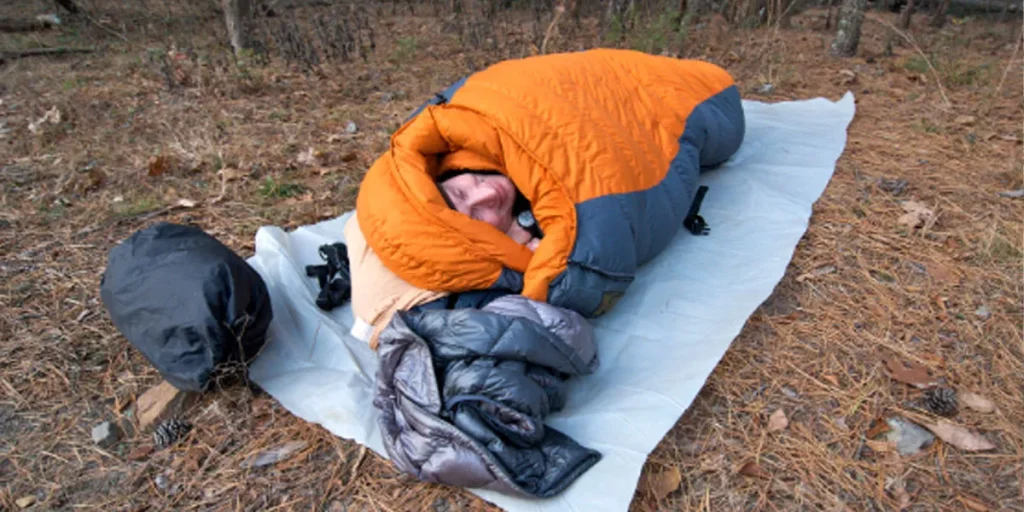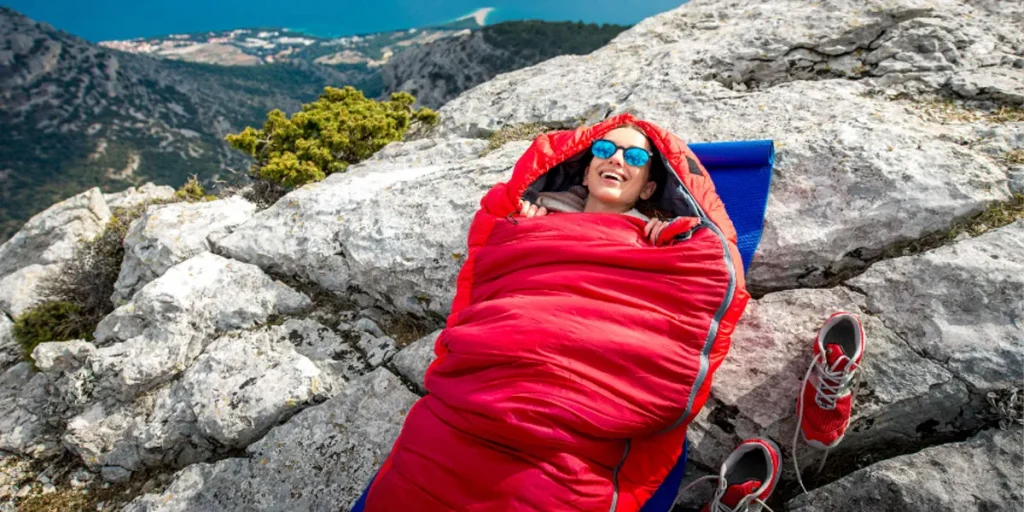A sleeping bag typically weighs between 1 to 7 pounds (0.45 to 3.18 kilograms). The weight can vary based on material, insulation, and design.
Whether you’re a seasoned backpacker or a casual camper, the weight of your sleeping bag can significantly impact your outdoor adventure.
Choosing the right sleeping bag is not only a matter of comfort but also efficiency and mobility constraints, especially when trekking over long distances.
Lightweight options are ideal for backpackers counting every ounce, while heavier, more luxurious bags might suit car campers or those staying put at a campsite.
With a variety of materials such as down or synthetic insulation, along with features that can add or subtract weight—from zippers to draft collars—understanding the specifics of sleeping bag construction is crucial for selecting the right balance between warmth and weight.
Sleeping Bag Weight Factors

When planning a camping trip or backpacking adventure, packing a sleeping bag is essential. The weight of your sleeping bag impacts your comfort and travel ease.
It hinges on several factors, such as materials, insulation, shape, design, and temperature ratings. Let’s dive into the specifics that determine sleeping bag weight.
Materials And Insulation
Materials play a crucial role in a sleeping bag’s weight. The outer shell could be from lightweight nylon or polyester, while the inner lining might be soft, breathable fabric for comfort.
The insulation type—down or synthetic—affects weight too. Down is often lighter than synthetic but might be less effective when wet.
- Down Insulation: Light, compressible, but more expensive.
- Synthetic Insulation: Heavier, more affordable, stays warm when wet.
Shape And Design Influences
The shape of a sleeping bag can impact its weight significantly. Rectangular bags offer more space but weigh more.
Mummy or barrel-shaped bags are trimmed for efficiency and save on weight. Features like hoods, zippers, and pockets add slight weight but increase functionality.
| Shape | Weight Impact | Space |
|---|---|---|
| Rectangular | Heavier | More |
| Mummy | Lighter | Less |
Temperature Ratings
Temperature ratings dictate the sleeping bag’s warmth. Bags rated for colder weather contain more insulation, raising the weight.
Lighter options are suitable for summer, while four-season bags are heavier yet more versatile.
- Summer Bags: Light, less insulation.
- 3-Season Bags: Moderate weight, fit for spring to fall.
- Winter Bags: Heaviest, designed for cold temperatures.
Sleeping Bag Categories And Weights

Choosing the right sleeping bag is crucial. Weight plays a key role. But how much do they weigh? It depends on the type.
Here’s a guide to help you understand the different categories and their typical weights.
Ultralight Bags
Ultralight bags are the lightest. Perfect for backpackers, they minimize load. Here’s what they weigh:
- Summer: Less than 1 pound
- Three-season: 1 to 2 pounds
- Winter: Up to 3 pounds
Three-season Bags
Three-season bags balance warmth and weight. Use them in spring, summer, and fall. Typical weights:
| Material | Weight Range |
|---|---|
| Synthetic | 3 to 4 pounds |
| Down | 2 to 3 pounds |
Winter Bags
Winter bags are the heaviest. They provide the most warmth. Expect these weights:
- Regular: 3 to 5 pounds
- Expedition: 5 to 8 pounds
Impact On Hikers And Campers
For those who wander into the wilderness, a sleeping bag is essential. It’s not just about warmth; it’s a balance of comfort, weight, and portability.
Hikers and campers must consider the impact of their sleeping bag’s weight to ensure an enjoyable outdoor experience.
Pack Weight And Portability
Choosing the right sleeping bag directly affects a hiker’s comfort and endurance. A heavy sleeping bag can weigh a hiker down, reducing the distance they can travel.
Lighter options offer greater freedom but may compromise on warmth.
- Ultra-lightweight bags: Ideal for long hikes, less than 2 pounds.
- Standard bags: Good for casual camping, between 2 to 4 pounds.
- Winter bags: Designed for cold weather, often over 4 pounds.
Every extra pound in a hiker’s pack means more energy expended. Thus, selecting the appropriate sleeping bag weight is critical for an enjoyable trip.
Comfort Versus Efficiency
The balance between comfort and efficiency is a key decision for campers. Sleeping bags come in various shapes and materials, impacting weight and warmth.
| Type | Weight | Comfort | Efficiency |
|---|---|---|---|
| Synthetic | Heavier | Less packable | Better insulation when wet |
| Down | Lighter | More compressible | Best warmth-to-weight ratio |
Many hikers opt for a down sleeping bag for its lightweight properties and excellent insulation, but understand that wet conditions can reduce its effectiveness.
Whether on a mountain or in a valley, campers must weigh their comfort needs against the efficiency of their gear to choose the best sleeping bag.
Weight Saving Strategies
Weight Saving Strategies for a backpacking trip can make a huge difference. Your sleeping bag is one of the key items that can add significant weight.
Lightening that load ensures comfort and less strain over long distances. Let’s explore ways to choose a lighter sleeping bag and pack it effectively.
Choosing The Right Bag For The Trip
The first step in reducing pack weight is selecting the proper sleeping bag. Not all trips require a heavy-duty bag. Here are strategies to pick a lightweight yet comfortable option:
- Consider the Season: A summer bag is lighter than a four-season bag.
- Check the Temperature Rating: Match the bag to the lowest temps you’ll face.
- Go for Down Fill: It offers the best warmth-to-weight ratio.
- Use a Sleeping Bag Liner: It adds warmth without much weight.
Effective Packing Techniques
Packing your sleeping bag the right way can also save weight. Here’s how to pack smart:
- Compression Bags: Shrink your bag’s volume significantly.
- Strategic Layering: Put heavier items near your back for better weight distribution.
- Multi-Use Items: Carry gear that doubles up, like a pillowcase that can be stuffed with clothes.
Remember: a well-packed bag feels lighter. Every ounce counts on the trail. With these strategies, you’re set for a lighter, smoother hike!
Care And Maintenance
A sleeping bag is a trusty companion on outdoor adventures. Keeping it in prime condition ensures it retains its warmth, comfort, and lightweight appeal.
Proper care can extend the life of your sleeping bag. It also maintains its insulating properties. This section explores how to care for your sleeping bag.
This helps with preserving both its longevity and optimal weight.
Longevity And Weight Preservation
To maintain your sleeping bag, consider the following tips:
- Store properly: Do not compress your sleeping bag for long periods. Hang it up or keep it in a large, breathable bag.
- Avoid over-washing: Frequent washing can damage the fill material. It leads to increased wear and tear.
- Use a liner: A sleeping bag liner can shield the bag from oils and dirt, making it last longer.
- Keep dry: Moisture can increase weight and damage insulation. Dry your sleeping bag after each trip.
These simple practices ensure your sleeping bag remains light. It also lasts through countless adventures.
Cleaning Tips To Maintain Insulation Quality
Keeping your sleeping bag clean is essential for maintaining its insulation quality. Follow these cleaning tips:
| Action | Benefit |
|---|---|
| Spot Clean | Reduces the need for full washes, preserves insulation. |
| Use Specialized Cleaners | Protects materials and maintains loft. |
| Hand Wash | Is gentler on fabrics and insulating materials. |
| Air Dry | Prevents damage from high heat and maintains fill power. |
Regular attention to cleaning can prevent build-up of dirt and body oils. This keeps your sleeping bag performing at its best.
FAQ About the Weight of a Sleeping Bag
What Is The Average Weight Of A Sleeping Bag?
The average weight of a sleeping bag varies between 1 to 7 pounds. Lightweight options are ideal for backpacking, while heavier models are better suited for car camping or cold weather.
How To Choose A Lightweight Sleeping Bag?
Choose a lightweight sleeping bag by considering materials like down or synthetic insulation, temperature rating, and the bag’s design. Ultra-light bags typically weigh less than 2 pounds.
Does Sleeping Bag Weight Affect Warmth?
Yes, sleeping bag weight often correlates with warmth. Heavier bags usually have more insulation, which can make them warmer.
However, advanced materials can also provide warmth without added weight.
What Factors Impact Sleeping Bag Weight?
Sleeping bag weight is impacted by insulation type, shell materials, size, and temperature rating.
Down-filled bags tend to be lighter than synthetic ones.
Conclusion
Selecting the right sleeping bag is crucial for a comfortable adventure. Remember, the weight varies by type, material, and insulation.
A lightweight bag suits backpackers; heavier ones may offer more warmth. Carefully consider your needs before making a choice, ensuring your next outdoor excursion meets your comfort and carrying capacity requirements.
Resources:
https://www.tsa.gov/travel/security-screening/whatcanibring/items/sleeping-bag
